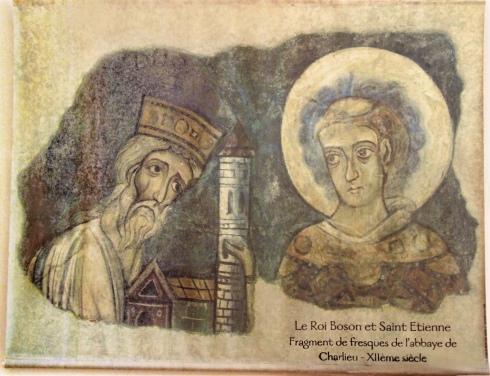Charles the Bald’s son Louis the Stammerer did not reign for a very long time. When he died, he left behind two young sons and a pregnant wife. Almost immediately, the kingdom got caught up in vicious factional intrigue between a number of people, noticeably Hugh the Abbot and Gozlin of Paris, both of whom we’ve met before on this blog; but the other West Frankish supermagnates as well as King Louis the Younger in the east got involved. The specifics are complex, but I summarise as follows: Louis the Stammerer had left the whole kingdom to his son Louis III, which in practice meant Bernard Plantevelue, Hugh the Abbot, and Boso. Gozlin, left out the loop, looked to Louis the Younger to be king instead. Both factions competed for Louis’ favour; eventually the impasse was solved by crowning both of Louis the Stammerer’s sons, Louis III and Carloman II, kings; and splitting the West Frankish kingdom in half. The competition, however, threatened to unseat Boso – and so this happened.
DD Provence no. 16 (25th July 879)
I, Boso, by grace of God that what I am, and my beloved wife the imperial offspring Ermengard, for love of God, give to the monastery of Montiéramey, etc., our goods which the lord emperor the most serene augustus Charles [the Bald] gave to us through a precept, which are in the district of Lassois: a demesne in the estate which is called Lanty with everything beholden to it, etc.
I, in the name of God, Boso, subscribed this charter of donation and ask that it be confirmed. The imperial offspring Ermengard consented. Sign of Count Richard [the Justiciar]. Sign of Count Theobald [of the Jura]. Sign of Count Bernard [of Gothia].
I, Archchancellor Stephen, at the command of the famous and illustrious man lord Boso and his wife lady Ermengard, wrote and subscribed this charter.
Given on the 8th kalends of August [25th July], in the year of the Incarnation of our lord Jesus Christ 879, in the 1st year after the death of the most glorious king Louis [the Stammerer].
Happily in the name of God, amen.
Archbishop Hincmar of Rheims wrote that Ermengard, who was the daughter of Louis II, emperor of Italy (would it kill one of them to not be called Louis?), nagged Boso to become king – she was the daughter of an emperor and felt that her birth entitled her to a higher-status husband. This doesn’t have to be dynastic, but certainly an emperor’s daughter was a high-status position and Boso, as in this charter, was clearly trying to have that position rub off on himself.
Otherwise, this charter is a masterpiece of hedging one’s bets. It’s a shame that it’s basically abbreviated notes on an original, because you can see that Boso already has an archchancellor, but isn’t yet ready to call himself king, using instead the famous phrase id quod sum, which could mean anything, but to those in know… well, the writing was on the wall.

7 thoughts on “Charter a Week 3, part 1: What I Am”